Fuzzy-Logic-Controlled Hybrid Active Filter for Matrix Converter Input Current Harmonics
Abstract
1. Introduction
- To propose a HAPF consisting of a SAPF and a series passive R-L-C filter.
- To obtain a THD within the recommended IEEE 519-2014 requirements with faster dynamic response time using fuzzy inferencing system.
- Separation of the high frequency currents was accomplished in the domain using a second order analogue filter with cutoff frequency of 30 Hz.
2. Review of Selected Literature
3. Methodology
- iS(t): Supply current.
- iL(t): Load current.
- i0: DC current component.
- i1: First harmonic component.
- ω: Angular frequency.
- θ: Phase shift.
- n: Harmonic number.
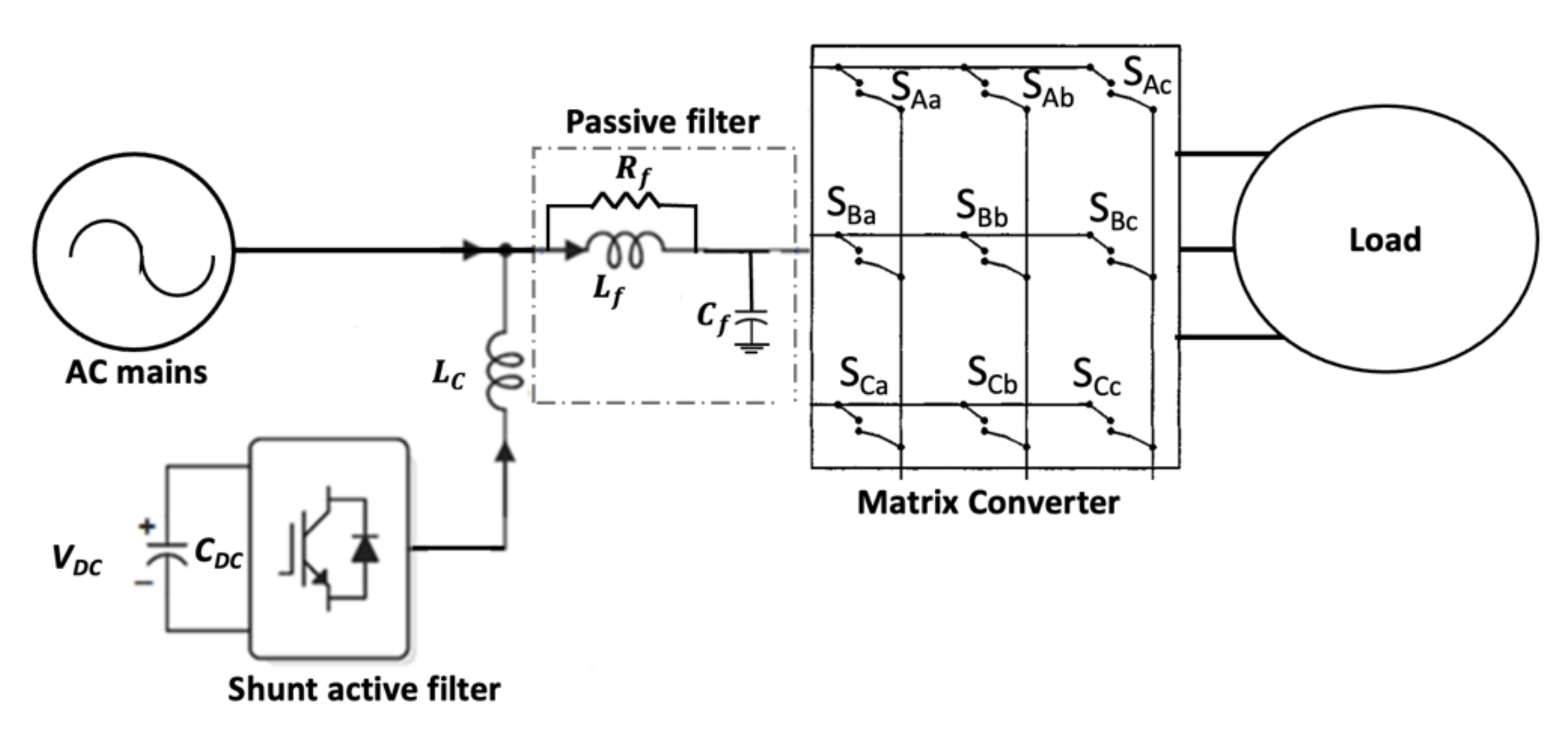
3.1. Design of Passive LC Filter Section of the HAPF
- VS: Supply voltage.
- iS: Supply current.
- P: Point of common coupling.
- Lf: Filter inductance.
- Cf: Filter capacitance.
- Rf: Damping resistor.
3.2. Design of Active Section of HAPF
- The selection of the DC voltage, Vdc.
- The selection of coupling inductance, Lc.
- The selection of the DC side capacitance, CDC.
3.2.1. Selection of Vdc and Lc
3.2.2. Selection of the DC Capacitance
- a: Overload factor (1.2).
- Vs: Phase voltage.
- If: Active filter ac side current.
- T: Recovery period (30 ms).
- K: Proportionality constant (0.1).
3.3. Control and Reference Current Extraction for the SAPF
- Total compensation.
- Partial compensation.
- s: Instantaneous complex power.
- v(t): Instantaneous voltage vector.
- i(t): Instantaneous current vector.
- p: Active power.
- q: Reactive power.
- S*: Desired apparent power.
- and : Direct component of the active and reactive power.
- and : Oscillatory component of the active and reactive power.
- iSH: Supply current harmonics.
- iLH: Load current harmonics.
- iC: Compensational current.
3.4. Fuzzy Inferencing Control System (FIS)
4. Simulation and Results
5. Discussion
6. Conclusions
Author Contributions
Funding
Conflicts of Interest
Nomenclature
| DC link capacitance | |
| Passive filter capacitance | |
| FIS | Fuzzy inferencing control system |
| HAPF | Hybrid active power filter |
| IMC | Matrix converter current at grid frequency |
| IS | Supply current |
| IC | Compensating current |
| IL | Load current |
| Passive filter inductance | |
| Active filter coupling inductance | |
| MC | Matrix converter |
| SAPF | Shunt active power filter |
| SMC | Matrix converter total power |
| VS | Supply Voltage |
| VSC | Voltage source converter |
| Grid frequency in radian | |
| Conner frequency in radian |
References
- Mutharasan, A.; Niranjan, K.; Rameshkumar, T.; Ajitha, A. Analysis of Power quality improvement in Matrix Converter for WEC System. Int. J. Appl. Eng. Res. 2014, 9, 11365–11372. [Google Scholar]
- Karaca, H.; Akkaya, R. A Novel Hybrid Compensation Method Reducing the Effects of Distorted Input Voltages in Matrix Converters. Elektron. Ir Elektrotech. 2019, 25, 15–21. [Google Scholar] [CrossRef]
- Chiang, G.T.; Itoh, J. Voltage Transfer Ratio Improvement of an Indirect Matrix Converter by Single Pulse Modulation. In Proceedings of the 2010 IEEE Energy Conversion Congress and Exposition, Atlanta, GA, USA, 12–16 September 2010; p. 9. [Google Scholar] [CrossRef]
- Dabour, S.M.; Rashad, E.M. Improvement of Voltage Transfer Ratio of Space Vector Modulated Three-Phase Matrix Converter. In Proceedings of the 15th International Middle East Power Systems Conference, Alexandria, Egypt, 23–25 December 2012; pp. 581–586. [Google Scholar]
- Goel, S.; Tiwari, D.; Pandey, M.K.; Bajpai, S. Power Quality Conditioners for Matrix Converter Using Shunt and Series Active Filters. Int. J. Electron. Electr. Eng. 2013, 6, 119–130. [Google Scholar]
- Li, D.; Wang, T.; Pan, W.; Ding, X.; Gong, J. A comprehensive review of improving power quality using active power filters. Electr. Power Syst. Res. 2021, 199, 107389. [Google Scholar] [CrossRef]
- Paul, P.J. Shunt Active and Series Active Filters-Based Power Quality Conditioner for Matrix Converter. Adv. Power Electron. 2011, 2011, 930196. [Google Scholar] [CrossRef]
- Karaman, O.A.; Erken, F.; Cebeci, M. Decreasing Harmonics via Three Phase Parallel Active Power Filter Using Online Adaptive Harmonic Injection Algorithm. Teh. Vjesn.—Tech. Gaz. 2018, 25, 157–164. [Google Scholar] [CrossRef]
- Wakileh, G.J. Effects of Harmonic Distortion on Power Systems. In Power Systems Harmonics; Springer: Berlin/Heidelberg, Germany, 2001; pp. 81–104. [Google Scholar] [CrossRef]
- Shah, A.; Vaghela, N. Shunt Active Power Filter for Power Quality Improvement in Distribution Systems. Int. J. Eng. Dev. Res. 2005, 13, 22–26. [Google Scholar]
- Koduah, A.; Svinkunas, G. Switching Harmonic Ripple Attenuation in a Matrix Converter-Based DFIG Application. In Proceedings of the 2022 IEEE 7th International Energy Conference (ENERGYCON), Riga, Latvia, 9–12 May 2022; pp. 1–7. [Google Scholar] [CrossRef]
- Yanchenko, S.; Meyer, J. Impact of Network Conditions on the Harmonic Performance of PV Inverters. In Proceedings of the 2018 Power Systems Computation Conference (PSCC), Dublin, Ireland, 11–15 June 2018; pp. 1–7. [Google Scholar] [CrossRef]
- Klatt, M.; Stiegler, R.; Meyer, J.; Schegner, P. Generic frequency-domain model for the emission of PWM-based power converters in the frequency range from 2 to 150 kHz. IET Gener. Transm. Distrib. 2019, 13, 5478–5486. [Google Scholar] [CrossRef]
- Meyer, J.; Haehle, S.; Schegner, P. Impact of higher frequency emission above 2kHz on electronic mass-market equipment. In Proceedings of the 22nd International Conference and Exhibition on Electricity Distribution (CIRED 2013), Institution of Engineering and Technology, Stockholm, Sweden, 10–13 June 2013; p. 0999. [Google Scholar] [CrossRef]
- Choudhary, J.; Singh, D.K.; Verma, S.N.; Ahmad, K. Artificial Intelligence Based Control of a Shunt Active Power Filter. Procedia Comput. Sci. 2016, 92, 273–281. [Google Scholar] [CrossRef]
- Kaufhold, E.; Meyer, J.; Schegner, P. Impact of harmonic distortion on the supraharmonic emission of pulsewidth modulated single-phase power electronic devices. Renew. Energy Power Qual. J. 2021, 19, 577–582. [Google Scholar] [CrossRef]
- Bollen, M.H.J.; Ribeiro, P.F.; Anders Larsson, E.O.; Lundmark, C.M. Limits for Voltage Distortion in the Frequency Range 2 to 9 kHz. IEEE Trans. Power Deliv. 2008, 23, 1481–1487. [Google Scholar] [CrossRef]
- IEEE Std 519-1992; IEEE Recommended Practices and Requirements for Harmonic Control in Electric Power Systems. Institute of Electrical and Electronic Engineers: New York, NY, USA, 1992.
- Casadei, D.; Serra, G.; Tani, A.; Zarri, L. Stability analysis of electrical drives fed by matrix converters. In Proceedings of the IEEE International Symposium on Industrial Electronics ISIE-02, L’Ayuila, Italy, 8–11 July 2002; Volume 4, pp. 1108–1113. [Google Scholar] [CrossRef]
- Petrauskas, G.; Svinkunas, G. Innovative Filter Topology for Power Grid Protection from Switching Ripple Harmonics Produced by Matrix Converter. Iran. J. Sci. Technol. Trans. Electr. Eng. 2018, 43, 495–505. [Google Scholar] [CrossRef]
- Monteiro, J.; Silva, J.F.; Pinto, S.F.; Palma, J. Matrix Converter-Based Unified Power-Flow Controllers: Advanced Direct Power Control Method. IEEE Trans. Power Deliv. 2011, 26, 420–430. [Google Scholar] [CrossRef]
- Monteiro, J.; Pinto, S.; Delgado Martin, A.; Silva, J. A New Real Time Lyapunov Based Controller for Power Quality Improvement in Unified Power Flow Controllers Using Direct Matrix Converters. Energies 2017, 10, 779. [Google Scholar] [CrossRef]
- Siva, B.V.; Babu, B.M.; Srinivas, L.R.; Tulasiram, S.S. Design of Shunt Active Power Filter for Improvement of Power Quality with Artificial Intelligence Techniques. Int. J. Adv. Res. Electr. Electron. Instrum. Eng. 2014, 3, 11304–11314. [Google Scholar] [CrossRef]
- Koduah, A.; Svinkunas, G.; Ampofo, D.O. Design of a Shunt Active Power Filter for Direct Matrix Converter Application. In Proceedings of the 2021 IEEE PES/IAS PowerAfrica, Nairobi, Kenya, 23–27 August 2021; pp. 1–5. [Google Scholar] [CrossRef]
- Alali, M.A.E.; Chapuis, Y.-A.; Saadate, S.; Braun, F. Advanced common control method for shunt and series active compensators used in power quality improvement. IEE Proc.—Electr. Power Appl. 2004, 151, 658. [Google Scholar] [CrossRef]
- Janabi, A.; Wang, B. Hybrid matrix converter based on instantaneous reactive power theory. In Proceedings of the IECON 2015—41st Annual Conference of the IEEE Industrial Electronics Society, Yokohama, Japan, 9–12 November 2015; pp. 003910–003915. [Google Scholar] [CrossRef]
- Jain, S.K.; Agrawal, P.; Gupta, H.O. Fuzzy logic controlled shunt active power filter for power quality improvement. IEE Proc.—Electr. Power Appl. 2002, 149, 317–328. [Google Scholar] [CrossRef]
- Akagi, H.; Watanabe, E.H.; Aredes, M. Instantaneous Power Theory and Applications to Power Conditioning, 2nd ed.; IEEE Press/Wiley: Hoboken, NJ, USA, 2017. [Google Scholar]
- Watanabe, E.H.; Monteiro, L.F.C.; Aredes, M.; Akagi, H. Instantaneous p-q Power Theory for Control of Compensators in Micro-Grids. In Proceedings of the 2010 International School on Nonsinusoidal Currents and Compensation, Lagow, Poland, 15–18 June 2010; p. 11. [Google Scholar]
- Bissey, S.; Jacques, S.; Le Bunetel, J.-C. The Fuzzy Logic Method to Efficiently Optimize Electricity Consumption in Individual Housing. Energies 2017, 10, 1701. [Google Scholar] [CrossRef]
- Roy, R.B.; Cros, J.; Basher, E.; Taslim, S.M.B. Fuzzy logic based matrix converter controlled indution motor drive. In Proceedings of the 2017 IEEE Region 10 Humanitarian Technology Conference (R10-HTC), Dhaka, Bangladesh, 21–23 December 2017; pp. 489–493. [Google Scholar] [CrossRef]
- Tsengenes, G.; Adamidis, G. Shunt active power filter control using fuzzy logic controllers. In Proceedings of the 2011 IEEE International Symposium on Industrial Electronics, Gdansk, Poland, 27–30 June 2011; pp. 365–371. [Google Scholar] [CrossRef]
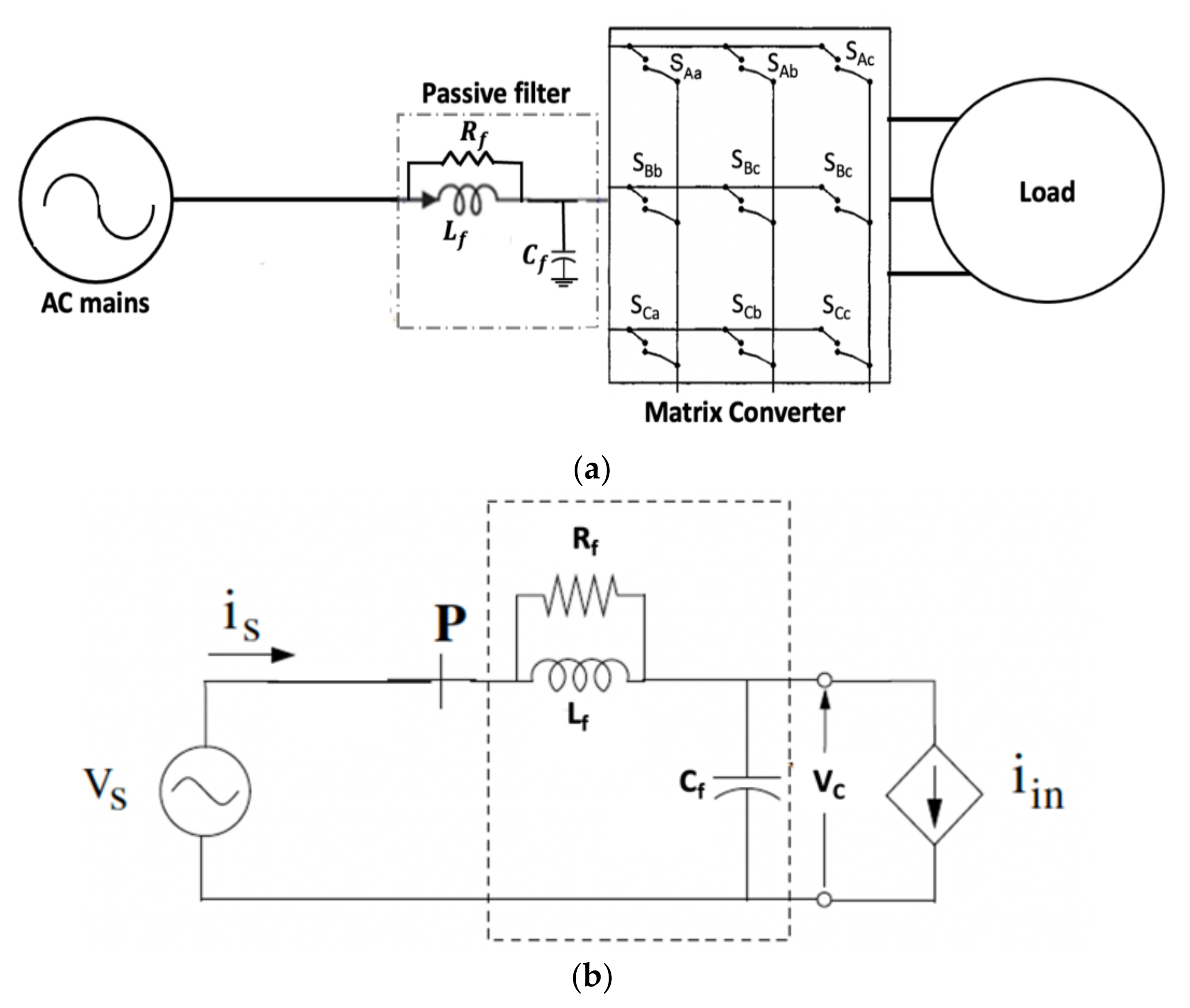

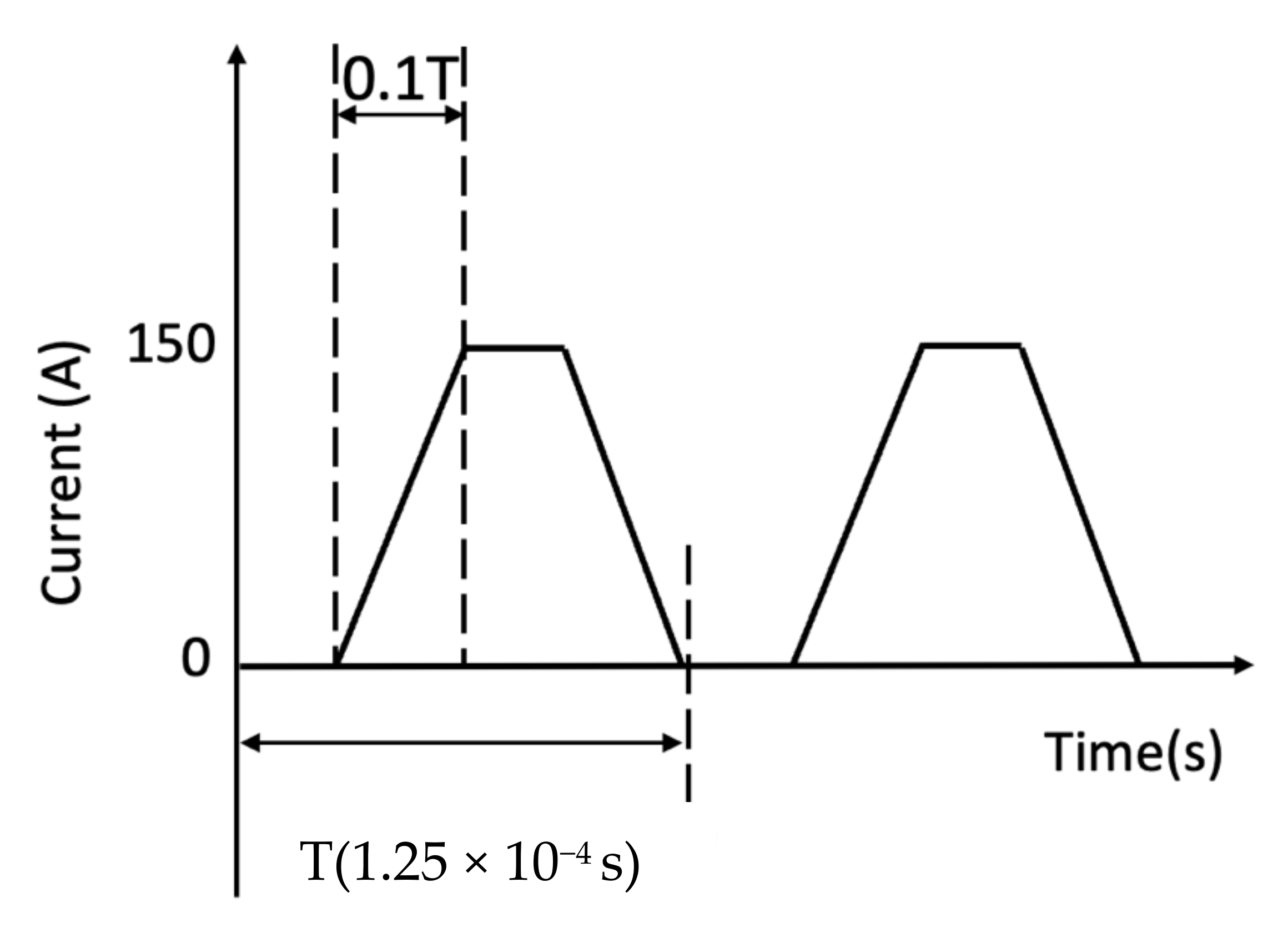
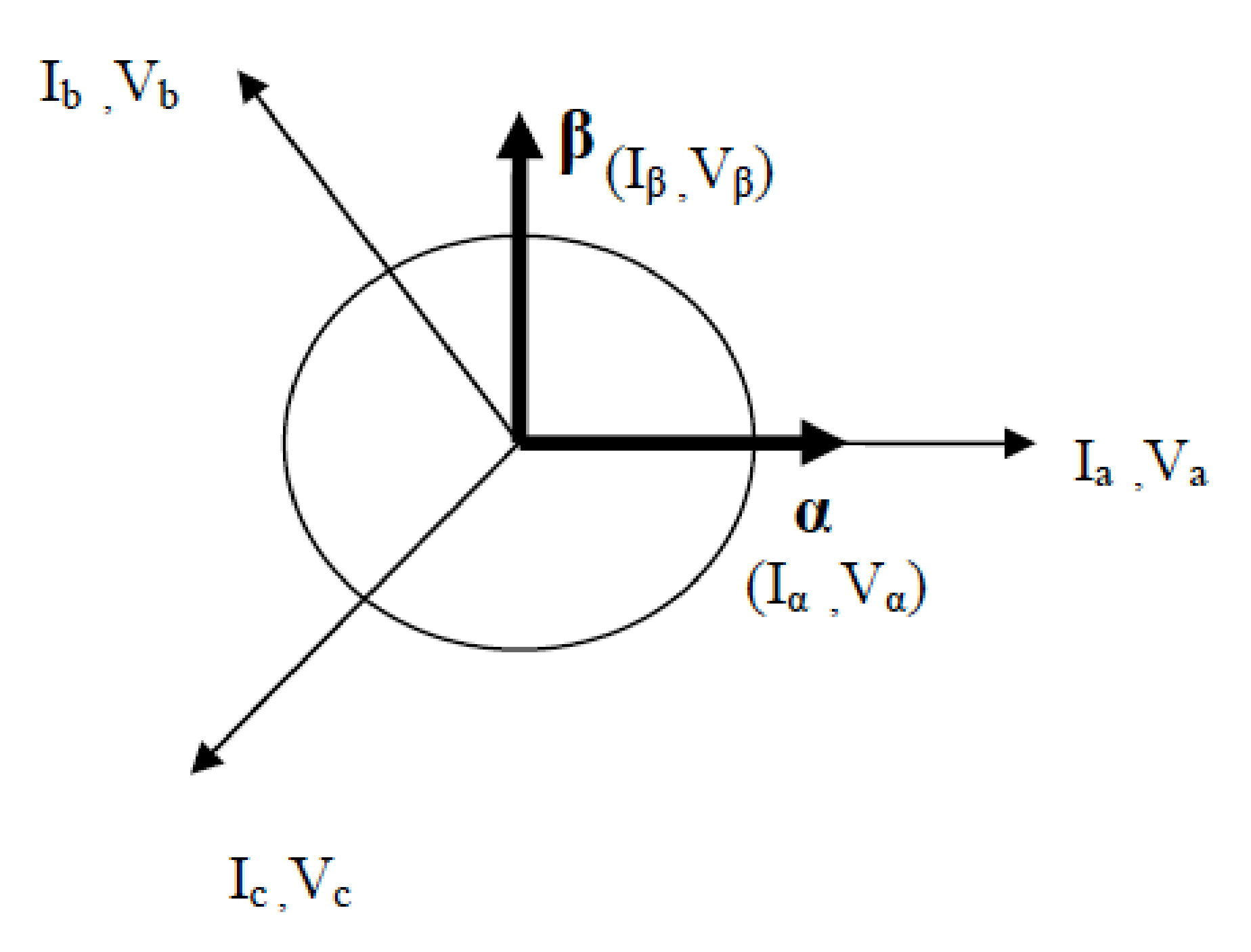
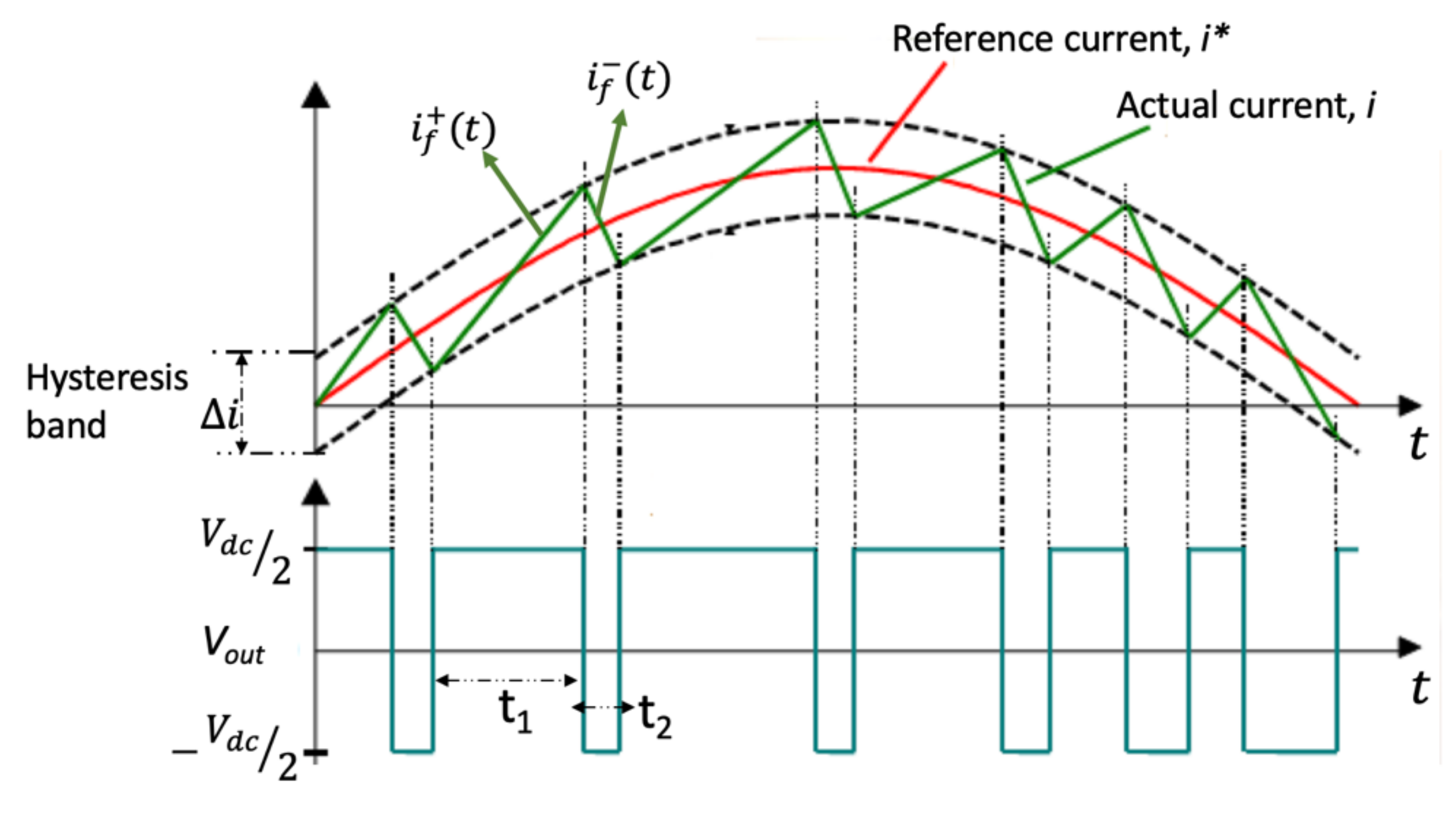




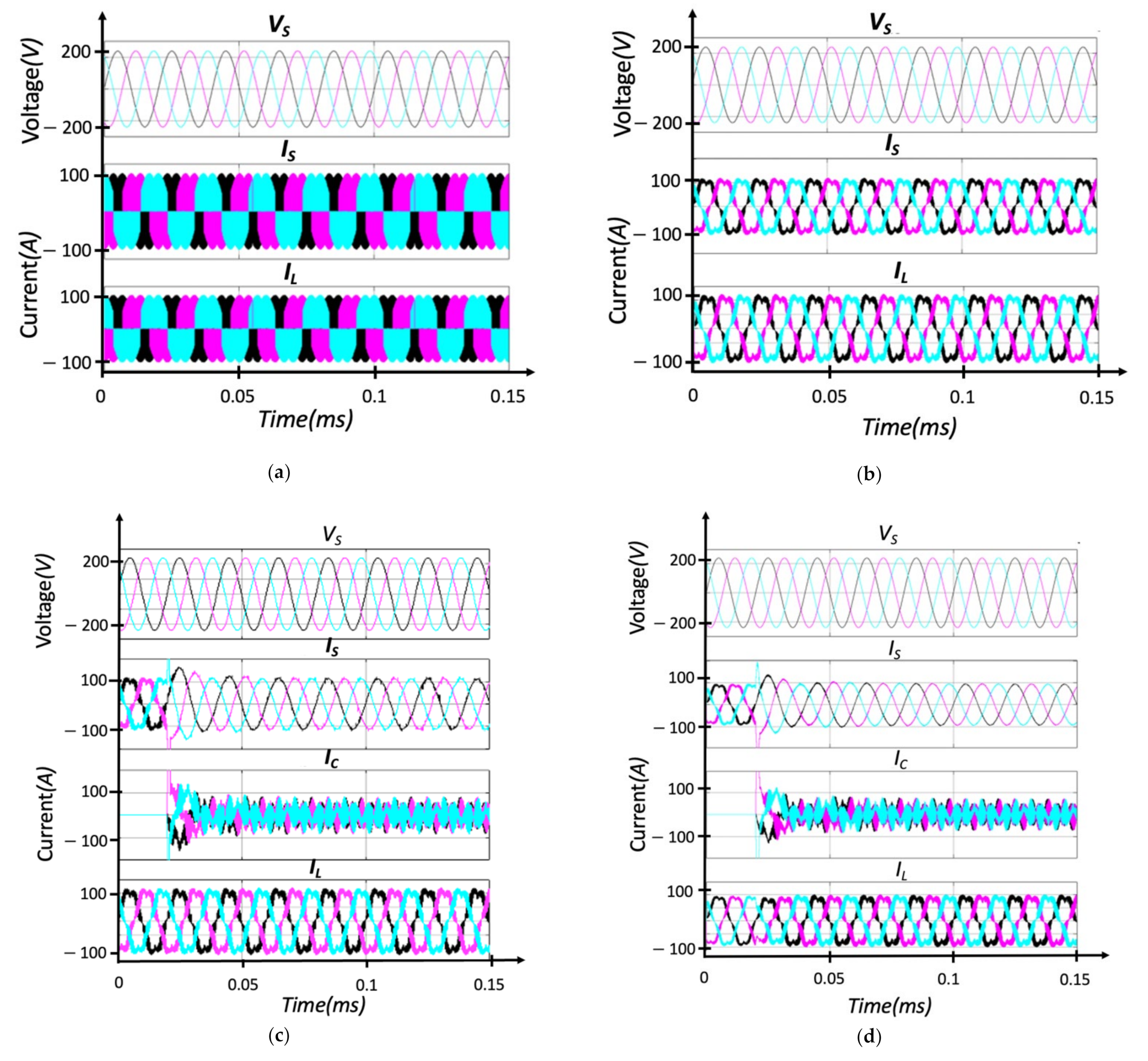

| References | Filter Type | Topology | THD% | Limitations |
|---|---|---|---|---|
| [1,14] | Active | Shunt active | >20 | Reduced power limit |
| [19] | Passive | R-L-C | <15 | Reduced power limit at Rd < 4 Ω |
| [20] | Passive | CLCR | <16 | Poor power factor, power limited below Rd < 4 Ω |
| [21,22] | Passive | R-L-C | <16 | Reduced power limit at Rd < 4 Ω |
| [2] | Hybrid | FIS | 4.16 | Not stable |
| [7] | Hybrid | Shunt and series active filters | 18 and 3 | Slow response |
| [25] | Hybrid | Shunt and series active filters | 1.5 | Good performance |
| MN | N | PN | Z | PP | P | MP | |
|---|---|---|---|---|---|---|---|
| MN | MN | MN | MN | MN | N | PN | Z |
| N | MN | MN | MN | N | PN | Z | PP |
| PN | MN | MN | N | PN | Z | PP | P |
| Z | MN | N | PN | Z | PP | P | MP |
| PP | N | PN | Z | PP | P | MP | MP |
| P | PN | Z | PP | P | MP | MP | MP |
| MP | Z | PP | P | MP | MP | MP | MP |
| Parameter | Value |
|---|---|
| Supply voltage (VL-L) | 400 V, 50 Hz |
| Matrix converter | 50 kW, 8 kHz |
| LC low pass filter values, LF, CF | 1 mH, 50 µF |
| DC reference voltage, Vdc | 677.69 V min, 700 V max |
| Coupling inductance, Linv | 115 µH |
| DC capacitance, CDC | 600 µF |
| Simulation | THD% before Compensation | THD% after Compensation | THD% of Dominant 155th Harmonic before | THD% of Dominant 155th Harmonic after |
|---|---|---|---|---|
| R-L-C filter only | 56.88 | 17.29 | 19.56 | 7.64 |
| PI-controlled HAPF | 56.88 | 1.25 | 19.56 | 0.15 |
| FIS-controlled HAPF | 56.88 | 1.16 | 19.56 | 0.37 |
Publisher’s Note: MDPI stays neutral with regard to jurisdictional claims in published maps and institutional affiliations. |
© 2022 by the authors. Licensee MDPI, Basel, Switzerland. This article is an open access article distributed under the terms and conditions of the Creative Commons Attribution (CC BY) license (https://creativecommons.org/licenses/by/4.0/).
Share and Cite
Koduah, A.; Effah, F.B. Fuzzy-Logic-Controlled Hybrid Active Filter for Matrix Converter Input Current Harmonics. Energies 2022, 15, 7640. https://doi.org/10.3390/en15207640
Koduah A, Effah FB. Fuzzy-Logic-Controlled Hybrid Active Filter for Matrix Converter Input Current Harmonics. Energies. 2022; 15(20):7640. https://doi.org/10.3390/en15207640
Chicago/Turabian StyleKoduah, Asare, and Francis Boafo Effah. 2022. "Fuzzy-Logic-Controlled Hybrid Active Filter for Matrix Converter Input Current Harmonics" Energies 15, no. 20: 7640. https://doi.org/10.3390/en15207640
APA StyleKoduah, A., & Effah, F. B. (2022). Fuzzy-Logic-Controlled Hybrid Active Filter for Matrix Converter Input Current Harmonics. Energies, 15(20), 7640. https://doi.org/10.3390/en15207640




